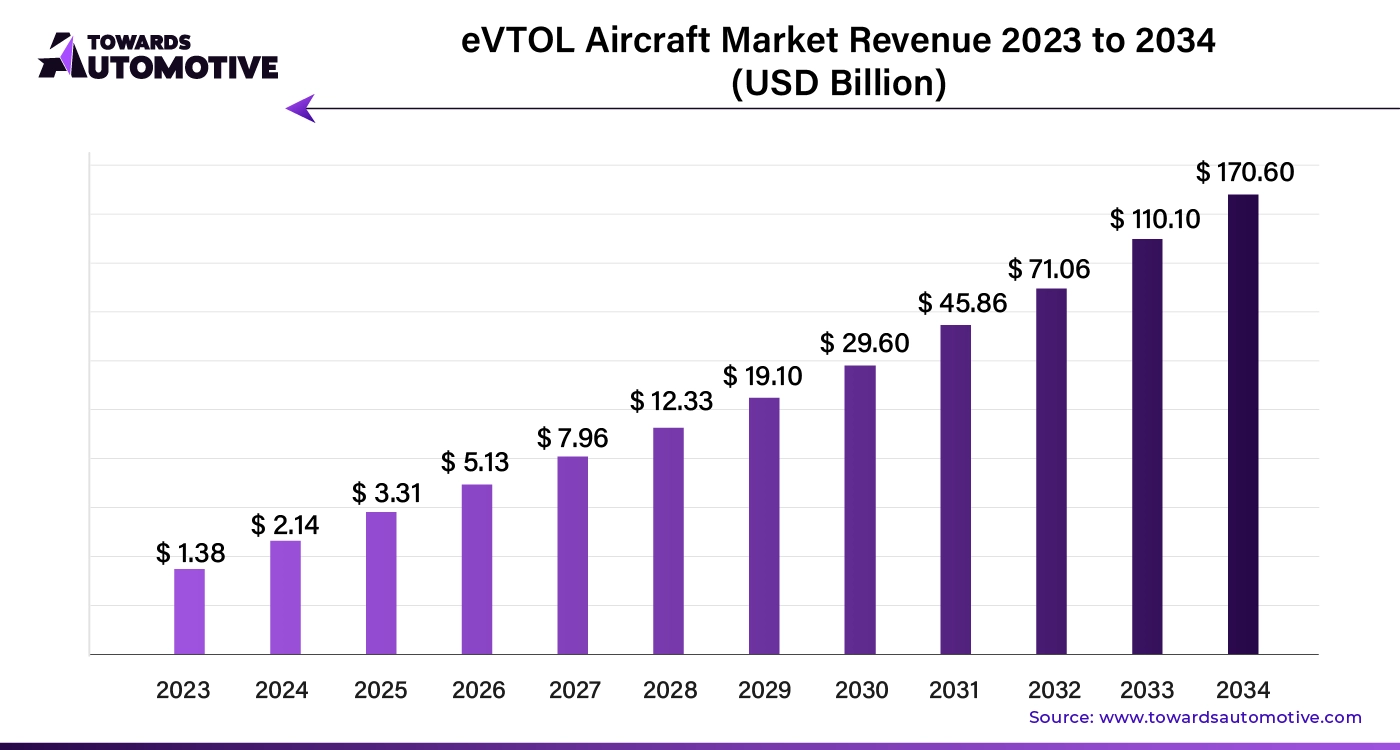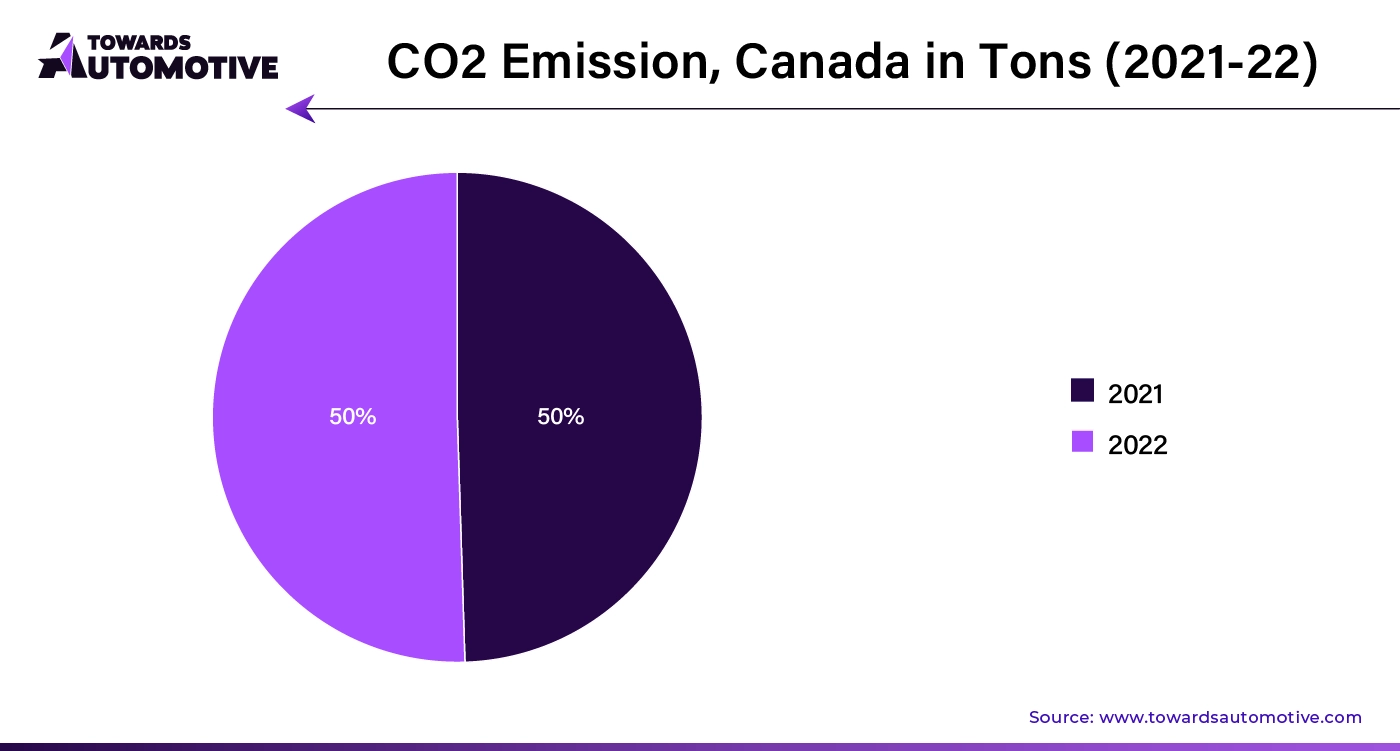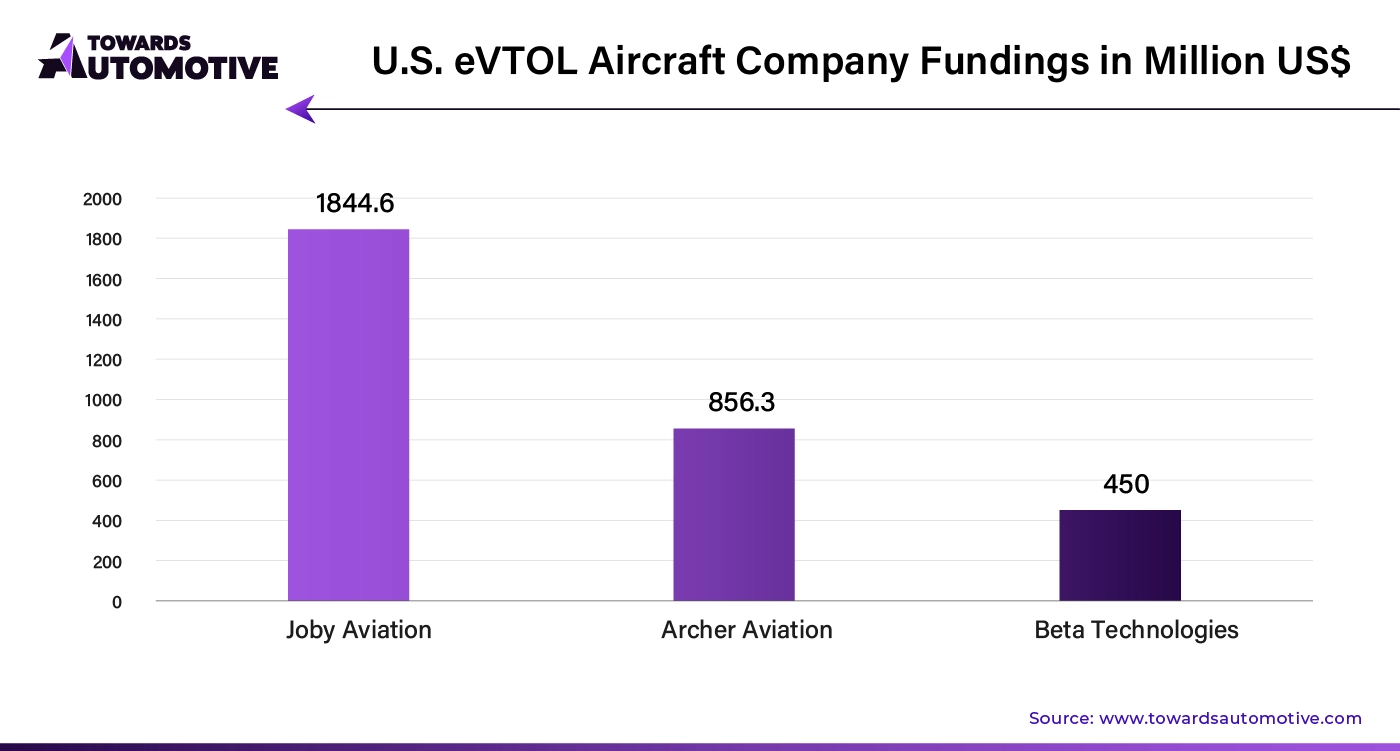March 2025
The global eVTOL aircraft market size is calculated at USD 2.14 billion in 2024 and is expected to be worth USD 170.60 billion by 2034, expanding at a CAGR of 54.95% from 2024 to 2034.

Unlock Infinite Advantages: Subscribe to Annual Membership
The Electric Vertical Take-Off and Landing (eVTOL) aircraft market is rapidly gaining momentum as a transformative segment within the aviation industry. It is generally driven by several advancements in electric propulsion technologies, automation, and the increasing demand for sustainable transportation solutions, eVTOL aircraft offer a promising alternative for urban air mobility. These aircraft are designed for short-distance flights and are envisioned to ease traffic congestion in metropolitan areas while reducing carbon emissions. The market is attracting significant investment from established aerospace companies, start-ups, and governments worldwide.
Factors such as urbanization, environmental concerns, and improvements in battery efficiency are expected to drive the growth of the eVTOL market. Moreover, key applications include air taxis, cargo transport, and medical emergency services. However, challenges such as regulatory approvals, airspace integration, and infrastructure development remain critical hurdles. Nonetheless, with ongoing technological innovations and collaborations between public and private entities, the eVTOL aircraft market holds considerable potential for revolutionizing air travel and urban mobility in the coming decade.
As infrastructure for electric vehicles expands and more manufacturers enter the market with innovative electric solutions, the Off-highway Electric Vehicle market is poised for substantial growth, shaping the future of sustainable industrial operations across multiple sectors.
Artificial Intelligence (AI) plays a pivotal role in the development and operation of eVTOL aircraft, contributing to advancements in automation, safety, and efficiency. One of the primary applications of AI in the eVTOL market is in autonomous flight systems. AI-driven algorithms enable eVTOL aircraft to operate with minimal human intervention, offering real-time decision-making capabilities for navigation, obstacle avoidance, and route optimization. This is especially crucial for urban air mobility, where complex, densely populated environments require advanced AI systems to ensure safe operations.
AI also enhances predictive maintenance by monitoring the aircraft’s systems in real time, detecting potential issues before they become critical, thus reducing downtime and maintenance costs. Machine learning models can analyze vast amounts of data from sensors and flight operations to predict failures and optimize performance.
Furthermore, AI is integral in air traffic management (ATM) for eVTOLs. It helps manage the coordination of multiple aircraft in crowded airspace, improving traffic flow and reducing the risk of collisions. As eVTOL usage scales up, AI will be key in ensuring that the air traffic system can handle increased volumes efficiently and safely. Overall, AI’s integration is critical for realizing the full potential of the eVTOL market, driving innovation and reliability in this emerging sector.
The rising demand for environmentally friendly solutions is a key driver of growth in the eVTOL (Electric Vertical Take-Off and Landing) aircraft market. As global concerns over climate change and pollution intensify, there is a growing push to reduce carbon emissions in the transportation sector. eVTOL aircraft, powered by electric propulsion systems, offer a cleaner alternative to traditional fossil fuel-based aviation, aligning with global sustainability goals. These aircraft promise significant reductions in greenhouse gas emissions and noise pollution, making them an attractive option for urban air mobility solutions such as air taxis and short-range flights.
Governments and regulatory bodies are increasingly supporting the development of electric aviation through incentives, funding for research, and stricter emissions regulations. In parallel, advancements in battery technology and energy storage systems are improving the efficiency and range of eVTOL aircraft, further fueling market growth. As cities look for solutions to reduce congestion and enhance sustainable transportation, the demand for eco-friendly air travel options is expected to soar. This emphasis on environmental benefits is not only shaping the future of urban transportation but also positioning the eVTOL aircraft market as a key player in the shift towards greener, more sustainable aviation solutions.

The eVTOL aircraft market faces several restraints, including regulatory hurdles, limited infrastructure, and high development costs. Obtaining regulatory approval for urban air mobility and integrating eVTOLs into existing airspace pose significant challenges. Additionally, the lack of dedicated infrastructure, such as vertiports and charging stations, hampers widespread adoption. High initial investments and technical complexities related to battery efficiency and flight range further slow market growth, making it difficult for new players to enter the market competitively.
Autonomous flight systems are creating significant opportunities in the eVTOL (Electric Vertical Take-Off and Landing) aircraft market, revolutionizing urban air mobility by reducing reliance on human pilots. These AI-driven systems enable eVTOLs to operate with minimal manual input, using advanced algorithms for real-time decision-making, obstacle avoidance, and route optimization. This autonomy is critical for scaling the eVTOL market, as it simplifies flight operations and reduces the need for extensive pilot training, making air travel more accessible and cost-effective.
The integration of autonomous flight technology opens doors for new applications, including air taxis, cargo transport, and emergency medical services, where quick response times are vital. Additionally, autonomous eVTOLs have the potential to improve safety, as they can analyze vast amounts of data and respond to changing flight conditions more rapidly than human pilots. Autonomous systems also facilitate the seamless management of air traffic in congested urban environments, ensuring efficient and coordinated flight paths.
As the technology matures, regulatory bodies are expected to develop frameworks for certifying autonomous eVTOL operations, further accelerating market growth. Overall, autonomous flight systems are at the forefront of innovation in the eVTOL market, creating new business models and expanding the potential for sustainable urban air transportation.
The fully electric segment dominated the market. The fully electric segment is a major driver of growth in the eVTOL aircraft market, fueled by the global shift toward sustainable and eco-friendly transportation. Unlike traditional aviation, fully electric eVTOL aircraft produce zero emissions, making them an attractive solution for reducing the environmental impact of urban air mobility. The growing emphasis on cleaner energy sources and stricter emissions regulations worldwide is pushing the demand for electric-powered eVTOLs, especially for use in congested urban environments where air quality is a concern.
Advancements in battery technology are enhancing the feasibility of fully electric eVTOLs by improving energy storage, efficiency, and flight range. These developments make electric aircraft increasingly competitive with traditional fossil fuel-powered vehicles in terms of performance and cost-effectiveness. Additionally, the fully electric segment offers lower operational costs, as electric motors require less maintenance compared to combustion engines, further driving interest from commercial operators.
The support from governments and regulatory bodies for electric aviation, through incentives and infrastructure development, is also crucial in accelerating market growth. The fully electric eVTOL segment is expected to play a central role in the future of urban air mobility, offering a cleaner, quieter, and more sustainable alternative to traditional transportation solutions, driving the eVTOL market forward.
The surveillance & monitoring segment held the largest share of the global EVTOL aircraft market. The surveillance and monitoring segment is a significant driver of growth in the eVTOL aircraft market, leveraging the unique capabilities of these aircraft for a range of high-demand applications. eVTOLs equipped with advanced surveillance technologies, such as high-resolution cameras, sensors, and data processing systems, are increasingly being used for aerial monitoring of urban areas, infrastructure, and natural environments. This capability is particularly valuable for tasks such as traffic management, disaster response, and environmental monitoring, where real-time data collection and analysis are crucial.
The demand for enhanced situational awareness and efficient monitoring solutions in densely populated urban centers is fueling interest in eVTOL aircraft. Their ability to operate in confined spaces and provide bird’s-eye views makes them ideal for surveillance tasks that require precision and flexibility. Furthermore, the integration of autonomous flight systems allows for continuous, unmanned operations, increasing the efficiency and coverage of surveillance missions.
Government agencies, security firms, and environmental organizations are investing in eVTOL technologies to improve their monitoring capabilities. As urban areas expand and the need for detailed, real-time information grows, the surveillance and monitoring segment is expected to drive substantial growth in the eVTOL aircraft market, offering new opportunities for both commercial and public sector applications.
The piloted segment held the dominant share in 2023. The piloted segment is a crucial driver of growth in the eVTOL aircraft market, as it bridges the gap between traditional aviation practices and emerging electric mobility technologies. Piloted eVTOLs offer a valuable transitional solution, combining the safety and reliability of human oversight with the benefits of electric propulsion. This segment is particularly appealing to early adopters and regulatory bodies, as it allows for gradual integration into existing air traffic systems while addressing safety concerns.
The piloted segment also facilitates the introduction of eVTOL aircraft into commercial applications such as air taxis and short-distance passenger transport. By leveraging experienced pilots, these aircraft can demonstrate their operational capabilities and reliability, building trust with passengers and stakeholders. Additionally, piloted eVTOLs serve as a testing ground for autonomous technologies, providing critical data and insights that can be used to refine and improve fully autonomous systems in the future.
Furthermore, the piloted segment supports market growth by catering to regulatory requirements that often mandate human oversight during the initial phases of eVTOL deployment. As the industry evolves and regulatory frameworks adapt, the piloted segment is expected to play a pivotal role in the widespread adoption and commercialization of eVTOL aircraft, driving overall market expansion.
The intracity (20km-100km) segment led the market in 2023. The intracity (20km-100km) segment is a major driver of growth in the eVTOL aircraft market, reflecting the increasing demand for efficient and rapid transportation within urban and metropolitan areas. This segment addresses a critical need for solutions that can effectively bridge short to medium distances, easing congestion and reducing travel times in densely populated cities. eVTOL aircraft designed for intracity operations offer a practical alternative to traditional ground transportation, which often faces delays due to traffic jams and limited infrastructure.
The focus on intracity travel is fueled by the desire to enhance urban mobility and improve connectivity between key city hubs, such as business districts, airports, and residential areas. eVTOLs provide a flexible and time-efficient mode of transport, capable of navigating through vertical take-offs and landings, which are ideal for urban environments where space is limited. Additionally, the growing emphasis on reducing carbon footprints and promoting sustainable transportation further supports the development of eVTOLs for these short to medium-range journeys.
As cities increasingly prioritize solutions to manage congestion and improve efficiency, the intracity segment of the eVTOL market is poised for significant expansion. This growth is driven by advancements in eVTOL technology, infrastructure development, and regulatory support, positioning intracity eVTOL services as a key component of future urban transportation systems.
The hardware segment dominated the EVTOL aircraft market in 2023. The hardware segment is a significant driver of growth in the eVTOL aircraft market, encompassing critical components such as propulsion systems, batteries, and avionics. As the eVTOL industry advances, the demand for sophisticated and reliable hardware increases, pushing innovation and technological development. Key hardware elements, such as electric propulsion systems, are crucial for achieving the efficient and environmentally friendly performance that eVTOLs promise. Advances in battery technology, including improvements in energy density and charging speed, are essential for extending the range and operational capabilities of eVTOL aircraft.
Additionally, advancements in avionics and control systems play a vital role in ensuring the safety and reliability of eVTOL operations. Enhanced hardware for navigation, communication, and autonomous flight systems is crucial for meeting the complex requirements of urban air mobility and integrating eVTOLs into existing air traffic management frameworks. The hardware segment also drives growth through the development of lightweight materials and aerodynamic designs that contribute to overall efficiency and performance.
As eVTOL technology evolves, ongoing investments in hardware development are crucial for addressing technical challenges and achieving commercial viability. This focus on hardware innovation not only accelerates the adoption of eVTOL aircraft but also supports the broader growth of the urban air mobility market, positioning it as a key area of expansion and opportunity.
North America led the eVTOL aircraft market share by 43% in 2023. The eVTOL aircraft market in North America is driven by several key factors, positioning the region as a leader in the emerging urban air mobility landscape. One major driver is the strong presence of advanced aerospace and technology companies in the U.S. and Canada, which are heavily investing in research and development for eVTOL technologies. Companies such as Joby Aviation, Archer, and others are spearheading innovations in electric propulsion, battery systems, and autonomous flight, creating a competitive ecosystem.
Government support and regulatory advancements also play a crucial role. The Federal Aviation Administration (FAA) is working on frameworks to certify eVTOL aircraft and integrate them into the national airspace, offering a pathway for commercial adoption. In addition, various states and cities are exploring urban air mobility (UAM) solutions to address traffic congestion and reduce carbon emissions, providing a market for eVTOL services like air taxis.
Environmental concerns and the push for sustainable transportation solutions are further accelerating demand for eVTOL aircraft. With increasing urbanization and the need for efficient short-distance travel, there is a growing interest in electric air mobility as a cleaner alternative to traditional transportation methods. These drivers collectively fuel the growth of the eVTOL market in North America, making it a key region for development and commercialization.

According to the IEEE Spectrum Org, the prominent eVTOL aircraft companies of the U.S. are Joby Aviation, Archer Aviation along with Beta Technologies and their investment for developing eVTOL aircrafts is 1844.6 million US$, 856.3 million US$ and 450 million US$ respectively.
Asia Pacific is expected to grow with the highest CAGR during the forecast period. The eVTOL aircraft market in the Asia-Pacific region is driven by a combination of rapid urbanization, increasing demand for efficient transportation, and government support for sustainable mobility solutions. With cities in countries like China, Japan, South Korea, and Singapore facing significant traffic congestion, eVTOLs offer a promising solution for reducing travel times in densely populated areas. The growing need for air mobility in these urban centers is fueling investments in eVTOL technologies and infrastructure.
Governments across the region are actively supporting the development of electric aviation through research funding, policy incentives, and pilot projects. For instance, China and Japan have been leading in battery technology and electric vehicle development, which is directly influencing the advancement of eVTOL aircraft. Additionally, regulatory bodies are beginning to explore frameworks for certifying eVTOL operations and integrating them into the airspace, which will be crucial for commercial adoption.
Asia-Pacific is also home to several key players in the eVTOL market, including established aerospace companies and innovative startups. This competitive ecosystem is driving innovation and accelerating the development of autonomous flight systems, battery efficiency, and safety features. The region's focus on sustainability, technological leadership, and addressing urban transportation challenges positions it as a significant growth market for eVTOL aircraft.
By Propulsion
By Range
By Operation
By Application
By System
By Region
March 2025
March 2025
February 2025
February 2025
We offer automotive expertise for market projections and customizable research, adaptable to diverse strategic approaches.
Contact Us